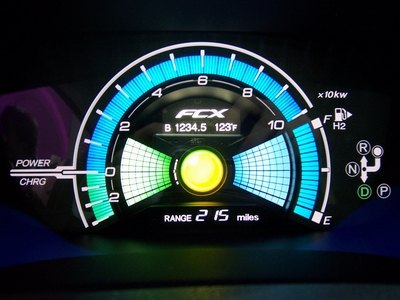Honda Starts Building Clarity. Clear?
Honda has started Japanese production of their spiffy-looking, highly-hyped hydrogen fuel cell-powered Clarity. And while the Clarity's a high tech halo machine destined for 200 carefully-selected customers, the same could be said of Tesla's EV Roadster. Of course, when Honda says production's begun, production's actually begun. More to the point, both companies are delighted to point-out their vehicles' zero emissions; and neither is particularly interested in discussing the full environmental impact– as in where does the power come from to charge the batteries or create liquid hydrogen? "Fuel-cell vehicles, which don't use fossil fuels and don't produce carbon dioxide, are necessary for the environment. We would like to make them more popular," Honda Chief Executive Takeo Fukui told Reuters. Methinks the media doth protest too little. "Fuel-cell vehicles are widely considered the ultimate longer-term alternative to today's conventional cars as they run on an inexhaustible and cheaper source of fuel — hydrogen, have no harmful tail-pipe emissions, and do not compromise driving performance." But here's the real news. "Among the first five customers for the FCX Clarity [who cleared the exhaustive qualification process] are actress Jamie Lee Curtis and U.S. filmmaker Christopher Guest." It's a sad day for Ed Begley Jr. and his wife, the over-spelled Rachelle Carson.
More by Robert Farago


































Comments
Join the conversation
To SunnyvaleCA: Not to be inane, but I'll term your new unit to be called "Gas Compression Energy Factor" or GCEF. So, really, you're saying that the FCX gets 18.25 miles per gallon-GCEF. And a gas ICE vehicle getting 20 MPG would in fact get 18.18 miles per gallon-GCEF. Could you please convert that back to regular old MPGs so we could compare the FCX to midsized all-wheel-drive SUVs? Actually, now that I look over your equations some more, shouldn't you be calculating something more along the lines of: 73 MPG / 3 GCEF = 24 MP(G-GCEF) and 20 MPG / .1 GCEF = 200 MP(G-GCEF). Now I'm all confused... To Juniper: If you are willing to accept that the entire FCX Clarity exercise isn't just for publicity, then I (graciously) am willing to accept your argument that Honda should be slated for making a press event too much like a press event.
Antohn, yeah that's all a bit confusing. I was lumping together the original energy of the gasoline + the additional 10% more energy needed to refine it and then comparing the total energy + source meterial needed in creating and delivering the hydrogen. For hydrogen you can use a whole bunch of natural gas as a source of hydrogen and use a lot of energy to reform and compress it; in this case you have used about 3x energy and 1x original natural gas to produce 1 unit of usable compressed hydrogen. Or you can use electrolysis and get hydrogen from water; even though you aren't using oil or natural gas or whatever, the energy required for electrolysis and then compression are huge; in this case you used 4x energy (electricity) to produce your 1 unit of compressed hydrogen. A simplified (if not particularly accurate) way of looking at it is: To put 20 gallons of gasoline in your tank you need 22 gallons to start with... 2 gallons are used just to refine the oil and transport it to your tank. With hydrogen (from natural gas reformation) to put 20 gallons of liquified hydrogen in your tank you need no fewer than 80 gallons to start with... 60 gallons are used up in refining, compressing, and transporting. Hydrogen via electrolysis is a bit more of a stretch in this simplified model, but just pretend you need 60 gallons of gasoline to burn to create electricity to run the electrolysis and compression, etc. Here's a great website. The website mostly compares hydrogen fuel-cell vehicles to battery operated ones. However, it clearly outlines the huge energy amounts required to deliver hydrogen to a fuel-cell vehicle. http://www.physorg.com/news85074285.html
Juniper - how many total GM fuel cells are on the road today for "commericial" testing (do you have stats on the mileage total, etc.) - you seem to speak from a position of knowledge (at least that is what your posts sound like)? Now I thought these hydrogen cars were to create a "mainstream" alternative to dino fueled cars anyway - that includes "consumers" and "celebrities". You seem to think that Honda's FCX vehicles and 600 cars they will lease are somehow empty promises and publicity stunts (we all know GM is well known to say one thing and then do another). For instance, let's count out how many GM Hywires we've seen go to production or be provided to anyone? Zip, zero, zilch.